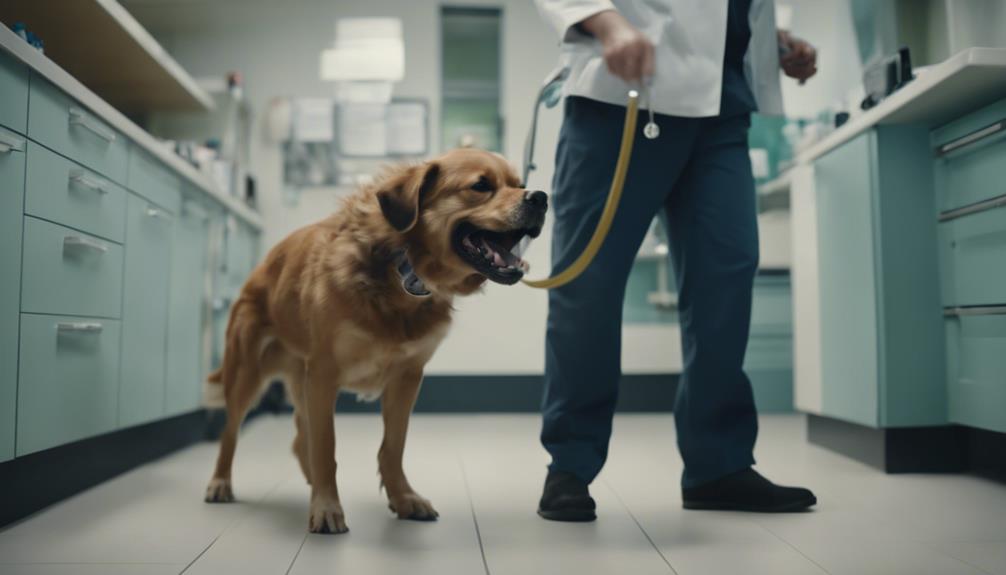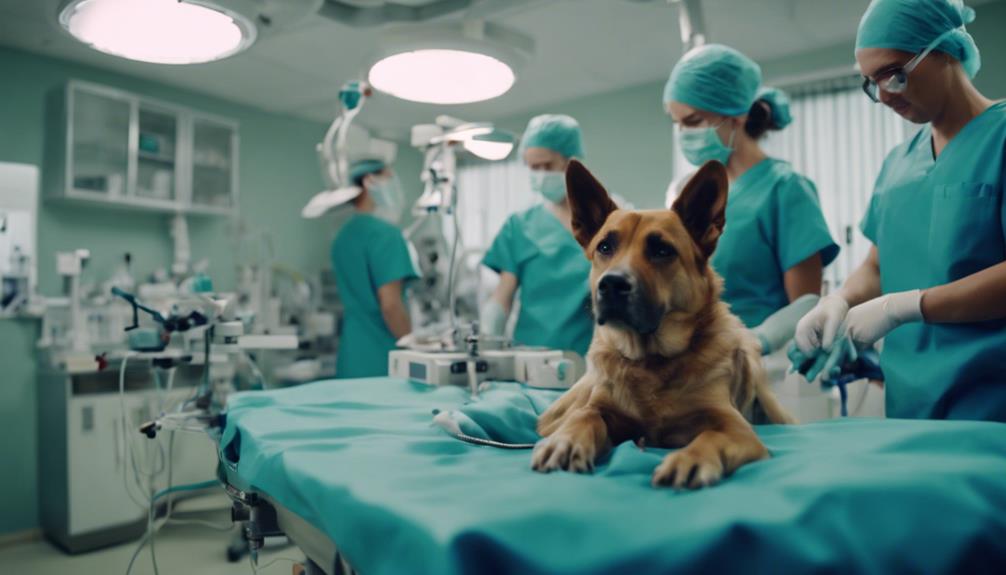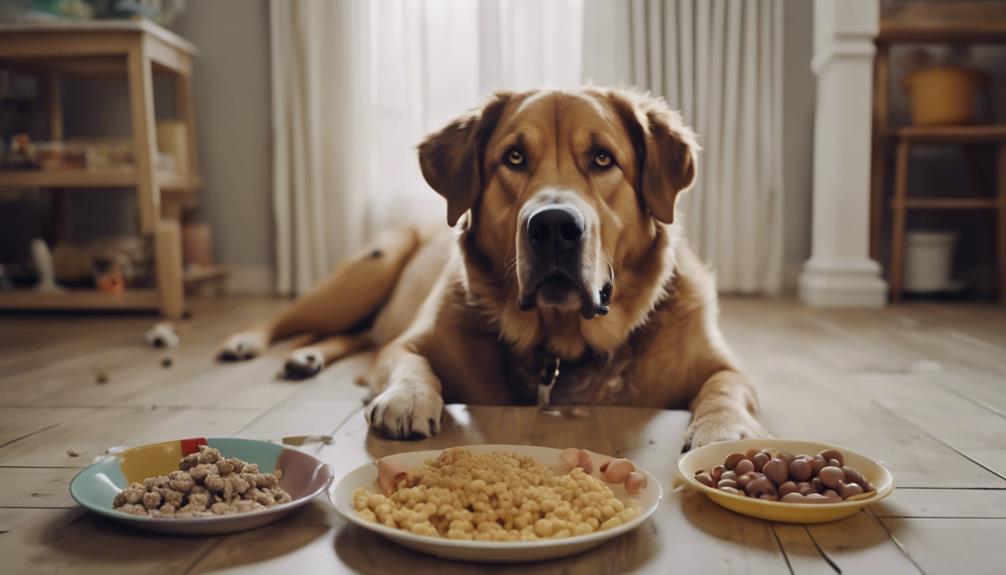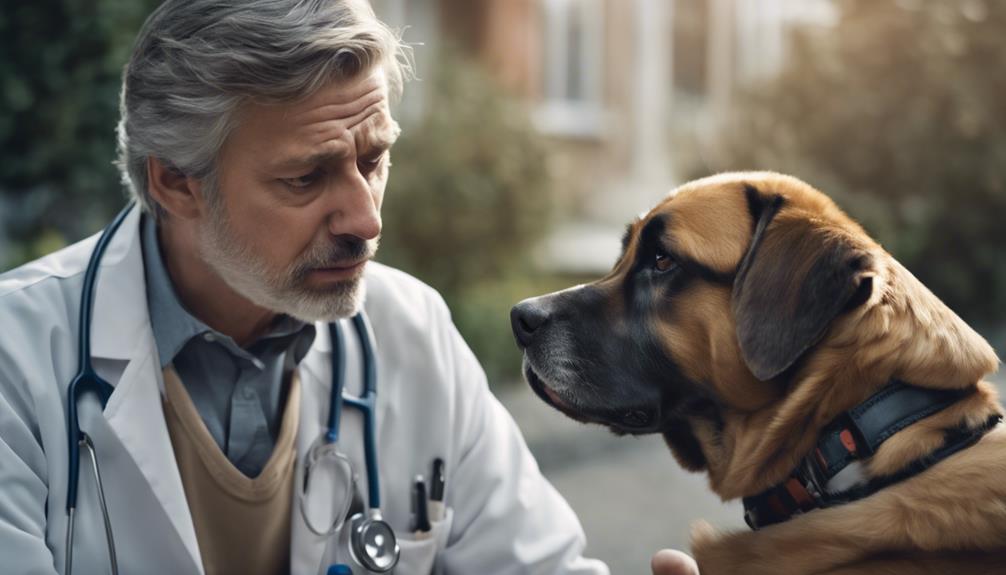Bloat in dogs, a condition that strikes with sudden severity, demands a nuanced understanding to navigate its complexities. From the insidious onset of symptoms to the critical intervention required, this gastrointestinal emergency presents a multifaceted challenge for both pet owners and veterinary professionals.
Exploring the intricate web of signs, causes, and treatment options can shed light on the gravity of this ailment, urging a closer examination of preventive strategies and long-term management. As the delicate balance between life and loss hangs in the balance, delving into the realm of bloat in dogs unveils a world where knowledge is indeed power.
Key Takeaways
- Bloat is a life-threatening condition in dogs caused by stomach distension and potential twisting.
- Recognize early signs like restlessness and swelling to seek urgent veterinary care.
- Immediate treatment involves stomach decompression and possibly surgery to prevent a fatal outcome.
- High-risk breeds benefit from preventative gastropexy to reduce the chances of bloat occurrence.
Understanding Bloat in Dogs
Bloat in dogs is a critical condition characterized by the accumulation of gas, food, or liquid in the stomach, leading to potentially life-threatening complications if left untreated. When this build-up occurs, the stomach expands, causing gastric dilation volvulus (GDV) in severe cases where the stomach twists, cutting off blood flow to vital organs.
This emergency situation requires immediate attention, as bloat is almost always fatal without intervention. The stomach can enlarge significantly, putting pressure on the lungs and constricting the openings of the stomach. Recognizing the signs of bloat and seeking prompt veterinary care are crucial to increase the chances of successful treatment and recovery for affected dogs.
Signs and Symptoms of Bloat
Recognizing the signs and symptoms of bloat in dogs is crucial for early detection and prompt veterinary intervention. Here are key indicators to watch for:
- Restlessness, pacing, drooling, and dry heaves are early signs of bloat.
- A swollen belly may be difficult to see in bigger or overweight dogs.
- Symptoms worsen with whining, excessive drooling, panting, and shallow breathing.
- Collapse can occur as bloat progresses.
If you notice any of these symptoms in your dog, especially if they are large or giant breeds, it is essential to seek immediate veterinary care to assess the severity of the condition and initiate appropriate treatment.
Emergency Care for Bloat

In cases of suspected bloat in dogs, prompt emergency care is essential to address the life-threatening condition and prevent further complications. If bloat is suspected, immediate veterinary attention is crucial.
Upon arrival, the veterinarian will stabilize the dog, which may include administering intravenous fluids and oxygen. X-rays or ultrasound may be performed to confirm the diagnosis and assess the severity of the condition. Emergency decompression of the stomach through a process called gastric decompression is often necessary to relieve pressure and improve blood flow to vital organs.
In severe cases where the stomach has twisted (GDV), emergency surgery to untwist the stomach and address any tissue damage is vital for the dog's survival. Early intervention significantly increases the chances of a positive outcome.
Diagnostic Tests for Bloat
Diagnostic tests play a crucial role in confirming the presence and severity of bloat in dogs, aiding in prompt and effective treatment decisions.
To diagnose bloat accurately, veterinarians may utilize the following tests:
- X-rays: These are essential to visualize the stomach size and position, confirming the presence of bloat.
- Ultrasound: Helps assess blood flow to the stomach and surrounding organs, crucial in severe cases of bloat.
- Blood tests: Can indicate organ damage or dysfunction due to decreased blood flow from the twisted stomach.
- Electrocardiogram (ECG): May be performed to monitor heart function, as bloat can impact cardiovascular health.
Surgical Interventions for Bloat

Surgical interventions play a critical role in the management of bloat in dogs, especially in cases where conservative measures have proven ineffective in alleviating the condition. When bloat is diagnosed, immediate surgical intervention may be necessary to save the dog's life.
The primary surgical procedure for bloat is a gastropexy, which involves attaching the stomach to the abdominal wall to prevent it from twisting again in the future. Additionally, during surgery, the veterinarian will untwist the stomach, assess for any tissue damage, and remove any compromised tissue.
Surgical interventions are crucial for addressing the underlying cause of bloat and reducing the risk of recurrence, ultimately improving the dog's prognosis and long-term outcome.
Importance of Early Treatment
Timely intervention is crucial in effectively managing bloat in dogs and significantly improving their chances of survival. When it comes to bloat, every minute counts. Here's why early treatment is paramount:
- Prevents tissue damage: Quick action can help prevent irreversible damage to the stomach and other vital organs.
- Reduces the risk of complications: Early treatment lowers the risk of complications such as sepsis or organ failure.
- Increases survival rates: Dogs that receive prompt care have a much higher chance of survival, with rates exceeding 80%.
- Minimizes recovery time: Acting swiftly can lead to a quicker recovery process, improving the overall well-being of the dog.
Risk Factors for Bloat

Understanding the risk factors associated with bloat in dogs is essential for identifying predisposing conditions that may increase the likelihood of this life-threatening condition. Certain factors can contribute to a dog's susceptibility to bloat, including breed, age, and feeding habits. Here is a table summarizing the key risk factors for bloat in dogs:
| Risk Factor | Description |
|---|---|
| Breed predisposition | Large and giant breed dogs are more prone to bloat due to their deep, narrow chests. |
| Age | Older dogs are at higher risk of developing bloat. |
| Feeding habits | Eating from elevated food bowls and consuming large meals quickly can increase the chances of bloat. |
Preventative Measures for Bloat
Prevention of bloat in dogs primarily involves implementing strategies to reduce the risk factors associated with this life-threatening condition. To help prevent bloat in dogs, consider the following measures:
- Slow Feeding: Encourage slow eating by using puzzle feeders or slow-feed bowls.
- Multiple Small Meals: Divide daily food portions into multiple small meals to prevent rapid eating.
- Avoid Vigorous Exercise After Eating: Limit intense physical activity immediately after meals to decrease the risk of bloat.
- Elevated Feeding: Use elevated feeding platforms to reduce air intake while eating.
Prognosis of Bloat in Dogs

To fully comprehend the potential outcomes and implications of bloat in dogs, understanding the prognosis is essential for informed decision-making and effective long-term care strategies. Bloat in dogs is a critical condition with a high mortality rate, particularly without surgical intervention.
The prognosis for dogs with bloat improves significantly with prompt detection and appropriate treatment. However, there is a risk of recurrence in dogs who have experienced bloat, emphasizing the importance of preventative measures and ongoing monitoring.
Long-term complications, such as organ damage, can also impact the prognosis of dogs with a history of bloat. Vigilance, timely intervention, and close veterinary supervision are crucial in managing bloat cases to improve the overall prognosis and quality of life for affected dogs.
Long-Term Complications of Bloat
Long-term complications of bloat in dogs may include persistent organ damage that can impact the overall health and quality of life of affected animals. These complications can lead to ongoing health issues that require careful management and monitoring.
Some potential long-term complications of bloat in dogs are:
- Scar tissue formation in the stomach lining, affecting digestion.
- Increased risk of gastric ulcers due to previous damage.
- Chronic gastrointestinal issues such as vomiting and diarrhea.
- Elevated susceptibility to future episodes of bloat, necessitating preventative measures.
Support and Care After Treatment

After undergoing treatment for bloat in dogs, it is crucial to provide comprehensive support and care to ensure the best possible recovery and long-term well-being of the affected animal. This includes monitoring closely for any signs of complications, administering medications as prescribed, and adjusting the diet to prevent future episodes. Additionally, scheduled follow-up visits with the veterinarian are essential to assess progress and address any concerns promptly.
| Support and Care After Treatment | Importance |
|---|---|
| Monitoring for complications | Critical |
| Administering prescribed medications | Vital |
| Dietary adjustments for prevention | Essential |
| Scheduled follow-up vet visits | Crucial |
| Promptly addressing any concerns | Necessary |
Conclusion
In conclusion, bloat in dogs is a serious gastrointestinal emergency that requires prompt recognition and intervention.
Understanding the signs and symptoms, emergency care procedures, diagnostic tests, surgical options, preventative measures, prognosis, and long-term complications associated with this condition is crucial for ensuring the well-being of canine companions.
By staying informed and proactive, both dog owners and veterinary professionals can work together to mitigate the risks and provide optimal care for dogs affected by bloat.




